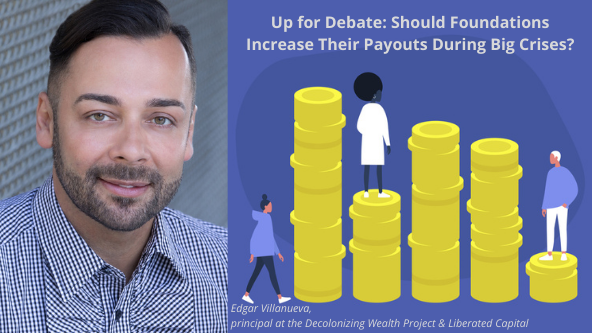
After an unprecedented year of crisis that has left tens of millions across the globe unemployed, without health care, and struggling to put food on the table, Larry Kramer, president of the William and Flora Hewlett Foundation, offers his solution: philanthropists should give less money to those in need. If foundations hold on to their resources now, he reasons that they will accumulate and preserve more capital to address future problems.
First, we must acknowledge that it is an enormous privilege for us to be in the position to even debate the question of how much foundations should be spending in this moment while so many are suffering. But let’s be clear: Kramer is making an argument for what is beneficial for the longevity of a foundation, rather than what will actually solve the problems our communities face now and in the future. Any foundation grappling with whether or not to increase giving in this moment should be deeply interrogating where that hesitation stems from. It’s not about concern for future generations—it’s about legacy, power, and control.

Kramer’s article demonstrates that he cares more about his foundation’s spending power than its healing power. His argument rests on the premise that present investments are not made in relation to future needs, but the fact is that future problems will be exacerbated as a result of failing to spend now.
The decision to withhold funding from those most impacted by this pandemic is a choice to defer the problem at hand and prolong the suffering of our communities. We could significantly alleviate the devastation of COVID-19 if we dramatically redistributed wealth right now. If we don’t, the problems we see today will impact generations to come.
Without rent relief, millions of people will face eviction and homelessness in the coming months. Meanwhile, 17 million people now have a new pre-existing medical condition with COVID-19, but no stable system to support them with rising health care costs. Nonprofit organizations that provide crucial services are shutting their doors for good as they struggle to bring in funding during this economic crisis. People desperately need money to survive, while billionaires in the United States have collectively grown their net worth by $1 trillion since the pandemic began.
After the 2008 recession, many foundations cut their grantmaking, creating a ripple effect that forced many nonprofit organizations to scale back their work, further crippling an already decimated economy. Today, increased philanthropic funding could immediately support food banks, health care providers, safe and socially distant education, poverty alleviation, economic development, and more.
Kramer’s perspective remains paternalistic and demonstrates clearly that those making decisions about how to spend philanthropic funds do not live in the same dire circumstances that so many people are currently experiencing across the county. Progress requires trust, and trust, like money, is an element that many foundations dole out in small percentages, with more given to white folks and white-led organizations than those led by people of color. Many foundation leaders do not trust those from whom opportunities and wealth have been extracted to make the best decisions for their communities.
Those most excluded and exploited by today’s broken economy possess exactly the perspective and wisdom needed to fix it, and they are saying they need money now. Funders should rely on the wisdom and lived experiences of communities, and embrace accountability, transparency, and trust rather than hoarding resources for their own agendas.
Philanthropy is itself a system that has both benefited from systemic racism and played a role in perpetuating it. Many foundations functionally serve as tax shelters for the wealthy, hoarding what should be publicly available funds that would otherwise support governmental services. For every dollar a billionaire gives to charity, taxpayers chip in up to 74 cents in lost tax revenue—when considering capital gains and estate tax reductions in addition to income tax.
In the United States, foundations are only required to distribute 5 percent of their funds annually. The majority—the remaining 95 percent—of philanthropic capital is tied up in Wall Street and big corporations, which means that for a foundation to increase its assets in anticipation of future needs, most will be investing more money in extractive and exploitative industries that profit off of Black and brown lives.
Kramer states that foundations should never exist in perpetuity, yet the core of his article is to prolong philanthropy’s control of our resources. He is essentially saying to his readers, ‘We want our grandchildren to have sandwiches to hand out to hungry children in the future—so let people go hungry now.’
Ultimately, Kramer is operating with a scarcity mindset—that this planet does not have enough resources to support everyone and we will eventually run out of money and resources. But the reality is that the wealthy are getting richer and philanthropy has been growing.
The Ford Foundation, Rockefeller Foundation, and others are now operating with their fourth and fifth generations of trustees. Generational wealth and power are perpetual, even dynastic, and the maintenance of both are often a priority for privileged wealthy families. As the concentration of wealth has grown, so has the number of private foundations—119,000 US foundations give away at least $72 billion a year.
Putting our declared values of equity to work by stabilizing communities of color will mitigate the impact of a future pandemic or another economic downturn. Focusing our efforts on addressing the racial wealth gap radically improves our country’s GDP, thus creating a stronger foundation to face future problems without the cataclysmic and disproportionate impacts on communities of color.
Foundations, and the immense tax deductions that encourage wealthy donors to give to them, exist for the sole purpose of distributing charitable funds. So why, in this moment of unprecedented crisis, should a foundation elect to withhold these crucial resources from those who are struggling?
Philanthropy is literally defined as the love of people. What is the opportunity cost of saving a life? We cannot protect the future and all of its many hypotheticals while also ignoring the pain of people in the present. We haven’t faced a crisis like this in more than fifty years. If there is ever a time that increased charitable giving is needed, it’s now.
Support SSIR’s coverage of cross-sector solutions to global challenges.
Help us further the reach of innovative ideas. Donate today.
Read more stories by Edgar Villanueva.

